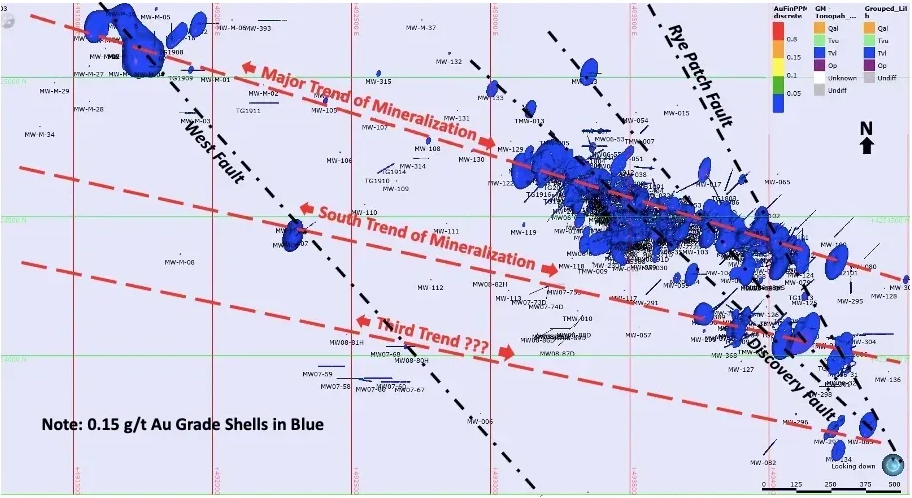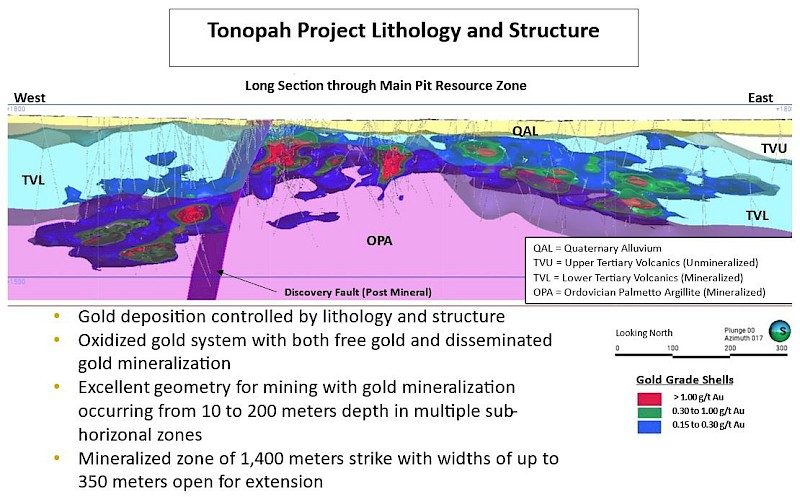Highlights
- Well oxidized low sulfidation, epithermal gold system
- Resource potential open for extension and infill along main trend
- 2022/23 drill programs identified new zones of near surface, high grade gold mineralization associate with north-south splay structures in easter half of Main Pit – required further infill drilling
- Eastern and western portion of Main Pit and South Pit zone open for extension with both step out and in-fill drilling
- Midway Hills area is primarily inferred mineralization open for extension
- Lack of drilling defines extent of mineralized zones
Geology
Tonopah contains a low-sulfidation epithermal gold system associated with near vertical quartz-adularia-gold veins hosted by Ordovician black argillite of the Palmetto Formation (Opa) and Tertiary rhyolitic volcanics. A ten-meter contact zone at the disconformity includes the deeply weathered Opa, and the colluvial/alluvial material at the weathered surface. When mineralized, this zone forms a shallowly dipping, manto-like zone of mineralization similar to the mineralized zones found in the overlaying tertiary volcanic sequences. Gold bearing veins occur in a series of en-echelon clusters along a 2.4-kilometer northwest-trending band of mineralization. Proximal to the major quartz-adularia veins, the wallrock is pervasively altered and mineralized. The main altered and mineralized zones are overlain by alluvial gravels, sand dunes, and playa deposits. The Tonopah property contains a low-sulfidation epithermal gold system associated with near vertical quartz-adularia-gold veins hosted by Ordovician black argillite of the Palmetto Formation (Opa) and Tertiary rhyolitic volcanics. A ten-meter contact zone at the disconformity includes the deeply weathered Opa, and the colluvial/alluvial material at the weathered surface. When mineralized, this zone forms a shallowly dipping, manto-like zone of mineralization similar to the mineralized zones found in the overlaying tertiary volcanic sequences. Gold bearing veins occur in a series of en-echelon clusters along a 2.4-kilometer northwest-trending band of mineralization. Proximal to the major quartz-adularia veins, the wallrock is pervasively altered and mineralized. The main altered and mineralized zones are overlain by alluvial gravels, sand dunes, and playa deposits.
Alteration and Mineralization
Alteration and mineralization at the Tonopah property are typical of low-sulfidation, volcanic-hosted epithermal gold deposits found elsewhere in Nevada and around the world. The deposit type is characterized by overall low original sulfide content, and quartz-adularia and clay-sericite alteration assemblages, among others. Gold mineralization occurs primarily as micro-fine free gold liberated by oxidation from a pyrite source. Course free gold can be found on some fracture planes. Vein textures are indicative of high level, near surface emplacement and include void fills, crustiform coatings, colloform banding, and comb structures. Lower grade gold mineralization often occurs as disseminations in favorable bedding horizons in the lower tertiary volcanic sequence as well as in the argillite host rocks and is very often associated with the argillite/volcanic contact zone. Similar deposits in Nevada have proven to be economic, including the Midas, Bullfrog and Round Mountain deposits. The proximity and similarities of Tonopah to other gold deposits does not, on its own, indicate that the Tonopah property should be similarly mineralized.


Structural Settings - Open Extensions

Exploration Upside


